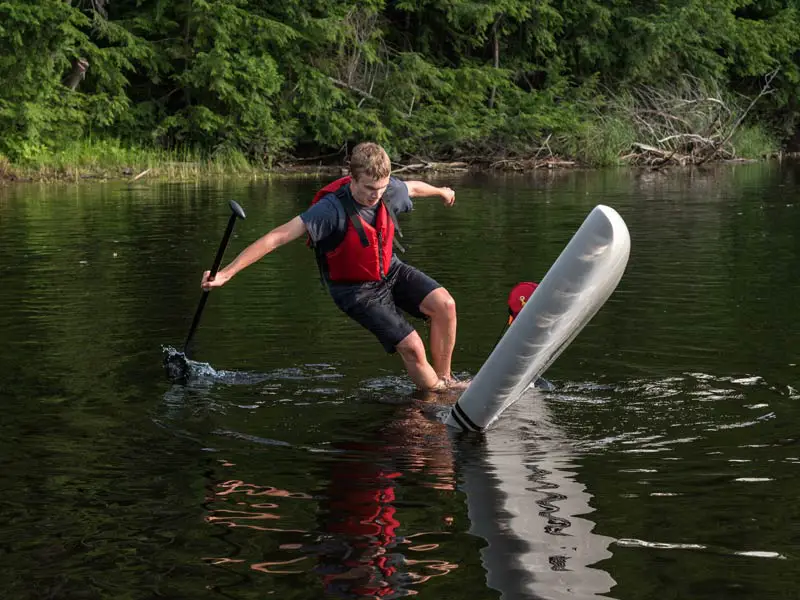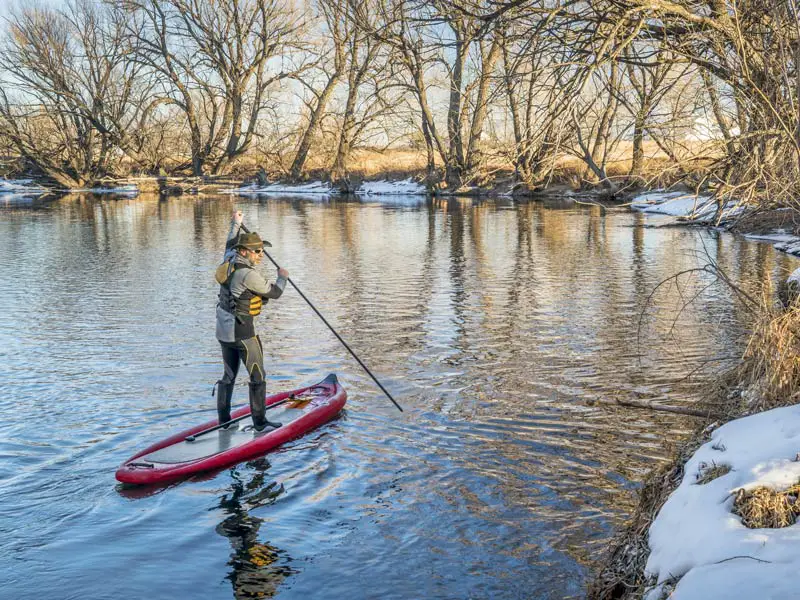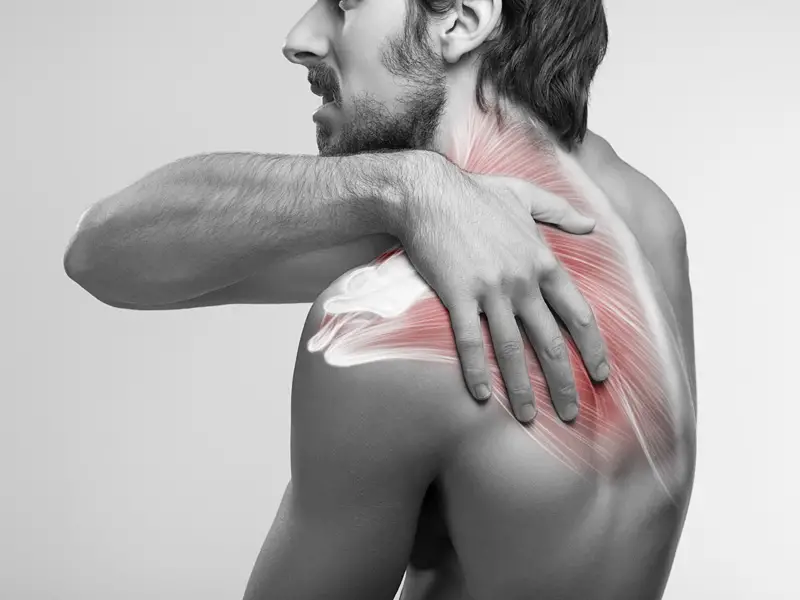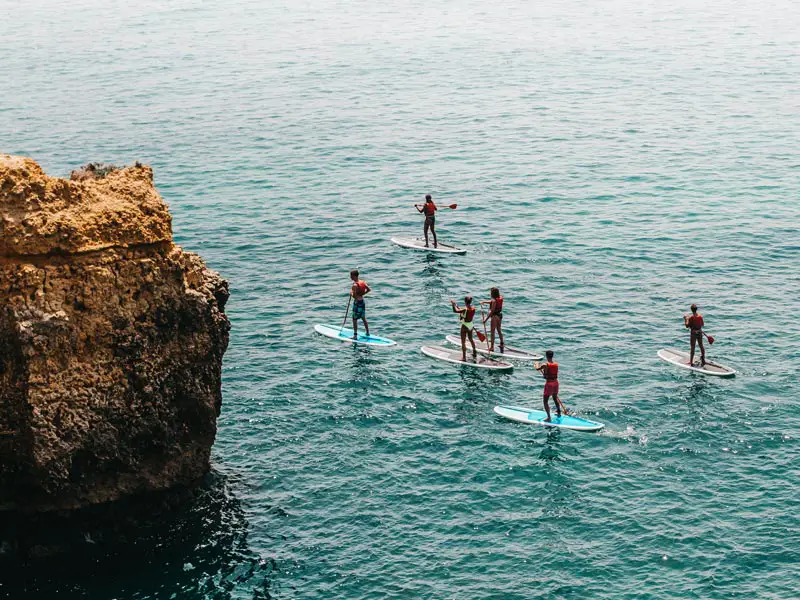Sure, paddle boarding looks like a lot of fun, but it’s common for first-timers to be on the fence about trying it. After all, you may be wondering how safe the activity really is.
So, is paddle boarding dangerous? In the grand scheme of things, stand up paddle boarding isn’t a particularly dangerous activity. But as with any watersport, there are always inherent risks that you need to consider.
Of course, the risks will differ depending on your level of experience and the conditions you are paddling in, but it’s important to know the risks and dangers in any sport you take part in. Here we list some of the most common (and some less common) hazards when paddle boarding, and expert tips to stay safe on the water.
Why Should I Paddle Board?
Stand up paddle boarding is one of the fastest growing sports globally and for good reason! A low impact, full body workout that is fun, and accessible to anyone that lives near a body of water.
Paddle boarding is way more interesting than most first-timers think and is a chance to get out in nature to re-energize and refresh. Nevertheless, it’s vital to stay safe while paddling.
Have The Right Gear Before You Start
Although not exactly a danger, it is crucial to have the correct gear before you start. Halfway across a lake or bay is not a great time to realize you have forgotten something important. I recommend having a list of what you need and checking it before you get in your car. This is coming from the personal experience of forgetting my drybag far too many times.
Use a paddle board that you are familiar with. If you have just bought a new board, test it on short trips before heading out to open water. You need to be comfortable turning the board and be able to balance in waves. A correctly sized paddle will take the strain off your lower back.
What Are The Dangers Of Paddle Boarding?
Drowning
Some people say that drowning is one of the most peaceful ways to go. I don’t know, nor do I intend ever to find out. However, when you are participating in any activity on or near the water, it is always a risk you must consider. Fortunately, with stand up paddle boarding you can easily reduce this risk.
Your board is your primary flotation device, and it is critical that you do not become separated from it. Use a board leash that is secured to your ankle. I prefer to use a coiled or semi-coiled leash so it doesn’t drag in the water, but you can use whatever one you prefer. If you are paddling on a river or in fast tidal waters, wear the leash attached to your waist, so you can release it if you become trapped.
Additionally, you should also wear a life jacket or personal flotation device, known as a PFD. Not only is it a sensible thing to do, in most cases it is a legal requirement. Again the type of PFD you use will depend on what type of paddling you are doing. In most cases a Type-V inflatable belt pack is sufficient. However, if there is any risk of being knocked unconscious such as surfing or river paddling, you are best to choose an inherently buoyant life jacket that will keep your face clear of the water.
Secondary Drowning
Secondary drowning, also known as delayed drowning, is a rare but serious condition sometimes caused when even a small quantity of water enters the lungs, causing a severe adverse reaction. It can be caused by both freshwater and saltwater, although the mechanism affecting the respiratory system is different. Symptoms can take between 1-48 hours so show and can include:
- Persistent coughing
- Labored breathing
- Chest pain
- Fatigue, exhaustion, or confusion
- Vomiting
If you experience any of these symptoms after inhaling water or a near drowning event, it is vital you seek urgent medical attention.
Fortunately, secondary drowning is quite rare and there are steps you can take to avoid it. If you realize that you are falling off your paddle board, hold your breath and shield your mouth and nose with a hand to avoid inhaling water.

Wind And Tide – Paddling In Adverse Conditions
Paddling against a strong wind or tidal flow can be dangerous. As a paddle boarder, your body acts as a sail in strong winds, which is great if you are down winding but can be exhausting if you are fighting against it to get back to shore. Tidal flow is the same, but it’s not as apparent. Think of tide like a treadmill; going against the flow may seem like you are moving but not getting you closer to your destination, and going with it will make you cover ground much faster.
The solution to this is straightforward, check the weather and tides before you go paddle boarding! If the weather is forecast to be bad, then you should stay on land. Windy is a great site to get a free forecast, but if you are looking for a more detailed forecast, PredictWind‘s paid plans are hard to beat. Alternatively, you could use television or radio forecasts, but they only give a general forecast and are not usually tailored for water users.
What Is Bad Weather For Paddle Boarding?
- Offshore Wind: This is when the wind is blowing from the land out to sea. The danger is that you could find it difficult to paddle back to land and need rescuing. As a rough guide, anything over 10 kts of wind offshore should make you reconsider your choice of activity for the day.
- Strong Onshore Wind: When the wind is blowing from the sea to the land, this will make the water choppy and difficult to stand up on your board. Not as dangerous as a strong offshore breeze, but anything over 15 kts of wind will make it difficult to control your board.
- Thunderstorms: Some areas of the world are prone to thunderstorms, often they can bring sudden bursts of strong wind, heavy rain or hailstones, and lightning. If you are ever out paddling and see a black thundercloud forming, my advice is to head straight for the closest point of land.

Risk Of Collision
Busy waterways can pose a hazard to paddle boarders. Just like on the roads, there are some terrible drivers out there. Some larger boats may struggle to see a paddle boarder under their bow in close quarters and have limited ability to maneuver. Avoid paddling in areas with a lot of traffic such as harbor entrances and marinas.
Make yourself more visible by wearing bright colors and if paddling at night, you should have appropriate navigational lights with you so you can be seen.
Of course, you can be a hazard to other water users. Be careful if paddling in a busy swimming area, accidentally hitting a swimmer with your paddle isn’t a great way to make friends. Stay out of very shallow water, falling onto rocks or coral can be very painful!
Hypothermia And Cold Water Shock
When paddle boarding in winter or in high latitudes, the cold air and water can be a danger. You should dress appropriately and consider wearing a wetsuit or drysuit if the water is 59F (15C) or less.
Hypothermia is the condition caused when your core body temperature gets too low. There are three classifications of hypothermia, mild, moderate, and severe. The biggest risk associated with hypothermia is the effect it can have on your ability to think clearly and make decisions, so it’s important to recognize the symptoms before they develop.
- Mild hypothermia symptoms are shivering, mild confusion, with cold red skin.
- Moderate hypothermia is defined as when you stop shivering and comes with an increase in confusion, slurred speech, and a reduction in fine motor skills.
- Severe hypothermia eventually leads to cardiac arrest, with sometimes the patient becoming so confused and hallucinating that they begin to undress.
If you notice any of the symptoms of mild hypothermia starting to develop it is time to head home, dry off, wrap up warm, and have a hot drink. If you or anyone you are paddling with develops suspected severe hypothermia, they should be rewarmed under medical supervision.
Cold Water Shock
Cold water shock is the physiological reaction when you fall into cold water. The blood vessels in your skin constrict to preserve heat, which increases resistance for blood flow, and your heart rate increases. This causes a rapid increase in blood pressure, which can cause heart attacks for even some healthy young adults.
Another problem with cold water shock is an involuntary gasp for breath, a feeling of panic, and your limbs locking up in response to the sudden cold. If you unexpectedly fall into cold water, you should try to stay calm, relax, and try to float on your back for a minute until the immediate effects wear off before trying to swim. A PFD is essential for stand up paddle boarding in cold waters. You should use either an automatic inflatable or inherently buoyant one, so you are not fumbling around for the activation pull cord.

Sunburn, Heat Exhaustion And Dehydration
Most people like to paddle board in summer and on sunny days. Hot weather and exercise means you should be drinking plenty of liquids to stay hydrated and replace lost fluids. Fortunately, heat exhaustion isn’t such a huge risk when paddle boarding. If you feel too hot you can get in the water to cool yourself down.
Sunburn is an ever-present issue on sunny days. The water reflects and magnifies the sun’s rays making it stronger than on land. Wear high factor sunscreen, sunglasses, a wide-brimmed hat, and light clothing. Excessive exposure to harmful UV rays significantly increases your risk of developing skin cancers in the future. The sun is strongest between 11 am -1 pm, so if you can avoid that time, you may save your skin from unnecessary damage. I personally paddle in the mornings, with the added advantage of my local beach being empty and calm water conditions.
Muscle Strain And Injury When Paddle Boarding
Stand up paddle boarding may be low impact sport, but as with any activity, sprains, strains, and pains can happen to even the most athletic paddle boarder. The most common injury is in the shoulder/upper arm, accounting for 33% of reported injuries. It is important to adopt a good posture and use your whole body, not just your arms to paddle. The power to propel your board should come from your core, and feel like you are doing an abdominal crunch with each paddle stroke.
It is important not to jump straight into intense paddling, you should slowly warm-up, which will greatly reduce the chance of causing yourself an injury. If something does start to hurt, adapt your paddling style, or take a rest. Pain is a signal that something isn’t quite right, and you should listen to your body. You may feel sore the day after a big paddle; if so, take a day off to let your body recover. Don’t overdo it.

Foot Pain
Foot pain is a common complaint for new paddle boarders. It is caused by your feet gripping your board for a long period of time and reducing blood flow. Try to shift your weight around so the pressure is not always in the same spot, and wiggle your toes to stimulate blood flow in your feet.
Hand Blisters
When you first start paddling, your hands won’t be used to the paddle’s repetitive motion and chafing. This is especially common with those of us who work in office jobs and have soft hands. Blisters are a part of paddling; you can wear gloves to avoid them or put band-aids on them until they heal into calluses. If you live an outdoor lifestyle already or work a trade, this probably isn’t going to be a problem for you.
Paddling Alone
Paddling with a friend or in a group is a good idea. Apart from the social aspect, even experienced paddlers in good weather can have accidents on occasion, it’s good to have someone watching your back. That isn’t to say that paddle boarding alone is dangerous or that you shouldn’t do it. However, it is good practice to let someone know when/where you are going paddling and what time you expect to return. This person should check up on you and raise the alarm if you fail to return. If you plan a longer trip, consider filling out a more detailed Float Plan to give the authorities a head start if you were to get into trouble.
Of course, in the 21st century, there is no reason to rely on other people to raise the alarm for you. You should at least carry a cell phone or handheld VHF radio in a dry bag for emergencies.

Conclusion: Is Paddle Boarding Dangerous?
Everything we do in life has an aspect of danger to it, from crossing the road to chopping vegetables. Stand up paddle boarding is no exception. Hopefully, you now have a better understanding of the potential dangers, and what you can do to avoid them. Is paddle boarding dangerous? No, not if you take sensible precautions it isn’t.

